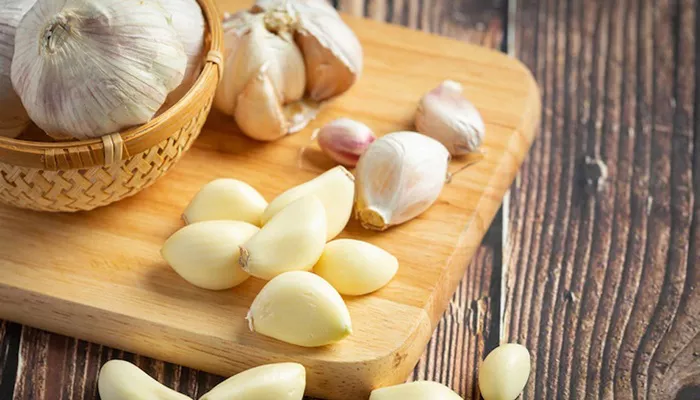A recent narrative review published in Nutrients explored the scientific evidence surrounding garlic’s effectiveness in lowering blood pressure.
Key Compounds in Garlic
Garlic contains various beneficial sulfur-containing compounds, notably alliin, which constitutes about 2.3% of fresh garlic bulbs. Other important compounds include S-allyl mercaptocysteine (SAMC), S-allylcysteine (SAC), allyl methyl sulfide (AMS), and allyl mercaptan (AM). These compounds are known for their anticancer properties and other health benefits.
Allicin, a significant compound in garlic, has several heart-protective properties. It prevents cell death, reduces oxidative stress, and combats inflammation. Additionally, allicin helps relax blood vessels, raises levels of “good” HDL cholesterol, and lowers “bad” LDL cholesterol and overall cholesterol levels. This compound can also decrease heart muscle enlargement and oxidative stress, both linked to heart disease.
Research indicates that allicin can reduce blood clotting and lower high blood sugar levels. Animal studies have shown that it effectively lowers blood pressure and prevents detrimental changes in blood vessels and the heart by interfering with specific signaling pathways.
Furthermore, allicin regulates blood pressure by widening blood vessels through mechanisms that include increasing the production of nitric oxide (NO). It also decreases harmful receptor expression while enhancing protective factors like Nrf2.
Allicin may reduce scar tissue buildup in the heart and lower the risk of arrhythmias by influencing potassium currents.
Another garlic compound, ajoene, works alongside allicin to prevent blood vessel wall thickening, a common issue in hypertension and atherosclerosis.
Mechanisms of Action
The review discusses various mechanisms through which garlic exerts its antihypertensive effects. SAC can lower oxidative stress by inhibiting the activity of nicotinamide adenine dinucleotide phosphate (NADPH) oxidase and trapping reactive oxygen species (ROS). Aged garlic has been shown to enhance superoxide dismutase activity in nephrectomy rats. Both allicin and SAC have been found to reduce ROS formation induced by angiotensin II.
Additionally, hydrogen sulfide, a compound produced by garlic, can lower blood pressure and promote vasodilation.
Polysulfides in garlic enhance NO regulation and stimulate hydrogen sulfide production through the catalytic effect of cystathionine c-lyase (CSE).
Garlic also reduces ROS generation and improves NO bioavailability, a key regulator of vascular tone. The Renin–Angiotensin–Aldosterone System (RAAS), which regulates fluid balance and blood pressure, can become overactive and lead to hypertension. One study demonstrated that SAC and captopril could work together to inhibit angiotensin-converting enzymes and lower blood pressure in guinea pigs and rats.
Limitations And Considerations
Despite the promising findings, more research is needed to clarify the role of garlic—both raw and aged—versus processed forms in managing metabolic syndrome and hypertension. The long-term effects of garlic on cardiovascular health are not yet fully understood.
Additionally, research should focus on determining the optimal dosage and delivery method to maximize garlic’s hypotensive effects. Patients should be aware that garlic does not provide immediate blood pressure reduction. Future studies should aim to confirm the long-term benefits and best practices for garlic use.
Allergic reactions to garlic should also be considered, as preliminary evidence suggests that about 3% of individuals may experience food hypersensitivity to garlic or onions. Cases of garlic-induced esophagitis and gastroenteritis have been reported.
The low protein content and stability of garlic bulbs may limit their use in some contexts. Further investigation into bioactive peptides and alternative expression methods is warranted.
Finally, when combined with medications affecting platelet aggregation, garlic can increase the risk of bleeding. These factors should be taken into account when considering garlic as a treatment for hypertension.


